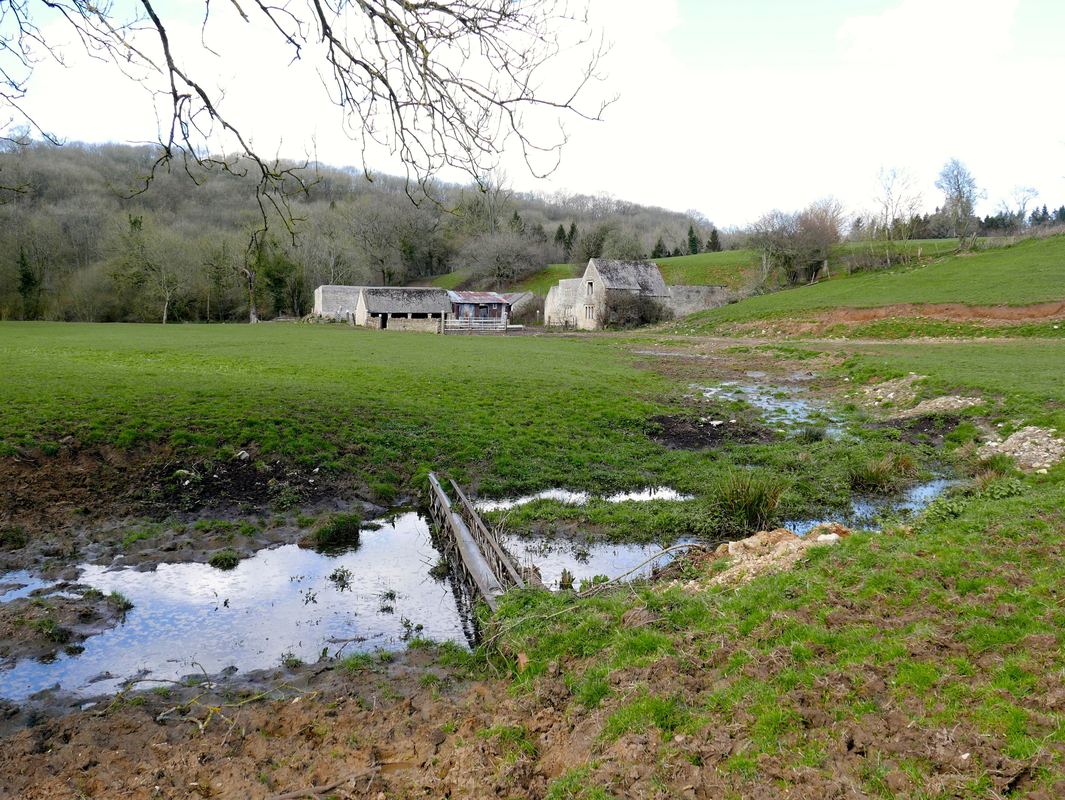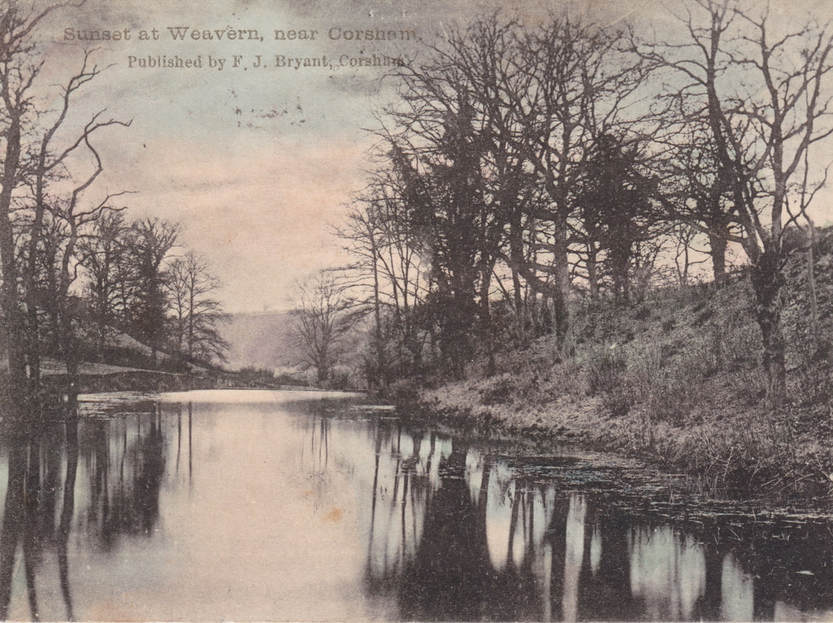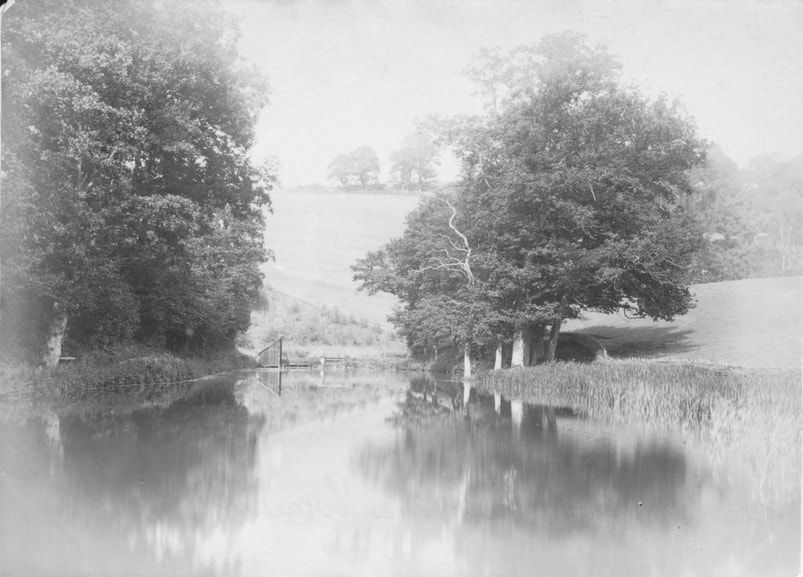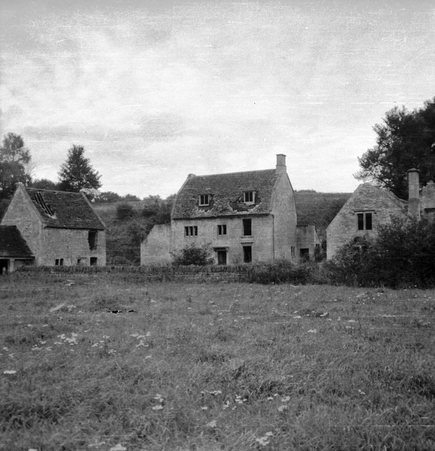|
Weavern Farm and Mill Verity Jeffery October 2017 Strictly speaking Weavern isn't within the modern Box parish; it is now designated as Corsham. It is on the boundary line of the Bybrook stream, called Box Brook shortly after Weavern. The name Weavern is reputed to be a corruption of Wavering, a reference to the meandering of the By Brook, although the name could equally refer to the process of cloth-weaving. Left: waterlogged ground at Weavern (courtesy Carol Payne) |
Fulling Mill
The farm and mill were closely associated for centuries. The first recorded mention was in 1332 when the farm was occupied by William De Vevere and the earliest mention of the mill was in 1536 as Weversmylle.[1]
In its early history it was involved in the cloth trade as a fulling mill, beating the cloth with hammers to wash it using fuller's earth as a soap and to thicken the material. In 1580 Robert Burgis, a clothier, died there. At the end of the Elizabethan period three mills were said to be housed under a single roof, an ancient fulling mill, one recent corn mill and one recent fulling mill.[2] The two latest mills were listed in 1608 when they were surrendered to the Baillife family. Being so close to Castle Combe it is possible that it was involved in making the famous red and white cloth at Castle Combe.
The fulling use continued for another century when John Browning married Alice Scott, daughter of Chippenham clothier, Walter Scott but the industry was in deep decline as the old trade moved north with the changes introduced in the industrial revolution. Fulling ceased in 1728 and the machinery was converted to corn milling.[3] We should not see the millers as wealthy entrepreneurs; rather the mill was owned by the Dukes of Somerset, probably part of their Trowbridge estates, and let to tenants.[4] By 1769 it was advertised for sale.
The farm and mill were closely associated for centuries. The first recorded mention was in 1332 when the farm was occupied by William De Vevere and the earliest mention of the mill was in 1536 as Weversmylle.[1]
In its early history it was involved in the cloth trade as a fulling mill, beating the cloth with hammers to wash it using fuller's earth as a soap and to thicken the material. In 1580 Robert Burgis, a clothier, died there. At the end of the Elizabethan period three mills were said to be housed under a single roof, an ancient fulling mill, one recent corn mill and one recent fulling mill.[2] The two latest mills were listed in 1608 when they were surrendered to the Baillife family. Being so close to Castle Combe it is possible that it was involved in making the famous red and white cloth at Castle Combe.
The fulling use continued for another century when John Browning married Alice Scott, daughter of Chippenham clothier, Walter Scott but the industry was in deep decline as the old trade moved north with the changes introduced in the industrial revolution. Fulling ceased in 1728 and the machinery was converted to corn milling.[3] We should not see the millers as wealthy entrepreneurs; rather the mill was owned by the Dukes of Somerset, probably part of their Trowbridge estates, and let to tenants.[4] By 1769 it was advertised for sale.
Converted to Paper Mill
Paper-making was a very valuable industry in the Georgian period as literacy became more-widely available. The process was very similar to fulling with hammers beating wood pulp and rags to merge and stiffen the fibres.
Paper-making required considerable power to break down the wood and it was vital that the stream should be powerful especially over summer months. There are numerous references to the strength of the By Brook at the site: A never-failing supply of spring and river water (1820); An unceasing water supply ... fit for manufacturing the finest writing paper (1831).[5] The power was not a natural occurrence and the leat (excavated water course) at the east end was strengthened. The sluice gate opening is still apparent on the site.
An advertisement in 1793 gives a good description of the property:
For sale by auction An excellent two vat paper mill with water wheel and outbuildings with orchard and grounds called Weavern Mill. Capable of making the finest paper. At present in the occupation of Mr John Butler. Is held for a term of eight years.
The landlord repairs the property.[6]
By 1802 the paper mill was owned by Charles William Wyndham when he was Member of Parliament for New Shoreham, Sussex, when a peace treaty had just been signed after the French Revolutionary Wars and Charles lost his seat in the ensuing general election. The lease of the mill changed hands to Henry Garner, papermaker, at a rent of 17s.4d, a heriot (death duty) of £5 and a goodwill cost on entry of £550.[7]
Henry was the tenant of the mill for the next 20 years. He was 52 years old when he took over the mill and an was an important person much respected and a deacon of Corsham Chapel.[8] By 1820 Henry was 68 years old, his wife had died five years earlier and he wanted to retire from work, offering a sub-lease. He died in 1823 and the mill struggled to find a buyer, being taken over by his son, also Henry Garner.
It was put up for sale in lots by Henry Garner, junior, in 1831. The farm and mill buildings, barn and three cottages together with 13 acres of pasture, arable, orchard and woodland were offered as one lot, and four pieces of arable land amounting to 25 acres as the other.[9] By 1834 the paper mill had failed and the leat had become disused.
Farming at Weavern
Thereafter milling activity was superseded by farming in the buildings. By 1851 22 year-old Thomas Henly was farming 57 acres there using three labourers to do the work. It appears to have failed because the mill was advertised to let in 1853 and the property was uninhabited in the 1861 census.[10] John Bence had another go at farming there in 1871 and he was succeeded by James Wright in 1878.[11] None of the attempts worked, possibly because the land was waterlogged much of the time.
By 1881 the Poulsom family had moved into Weavern Farm and they ran it for the next thirty years. Joseph Poulsom, a butcher and farmer of 44 acres from Velly, Corsham, had married Jane and they had two sons, Henry and Charles William Green Poulsom. Henry was the elder and he took over Weavern in 1881 with his wife, Lucy Sophia, twelve years his senior. When Joseph died in 1885, his widow, Jane, continued farming in her own right at Ridge Farm, Linleys, Corsham, looking after two of her children, daughter Mary A and son Charles William, and her grandchild Percy James (born Biddestone in 1881). Charles William took over Ridge Farm on a tenancy from the Neston Estate and was running a dairy and arable business there in 1939 until his death in 1947 when his coffin was carried on a farm cart pulled by his favourite horse, Duke.[12]
Paper-making was a very valuable industry in the Georgian period as literacy became more-widely available. The process was very similar to fulling with hammers beating wood pulp and rags to merge and stiffen the fibres.
Paper-making required considerable power to break down the wood and it was vital that the stream should be powerful especially over summer months. There are numerous references to the strength of the By Brook at the site: A never-failing supply of spring and river water (1820); An unceasing water supply ... fit for manufacturing the finest writing paper (1831).[5] The power was not a natural occurrence and the leat (excavated water course) at the east end was strengthened. The sluice gate opening is still apparent on the site.
An advertisement in 1793 gives a good description of the property:
For sale by auction An excellent two vat paper mill with water wheel and outbuildings with orchard and grounds called Weavern Mill. Capable of making the finest paper. At present in the occupation of Mr John Butler. Is held for a term of eight years.
The landlord repairs the property.[6]
By 1802 the paper mill was owned by Charles William Wyndham when he was Member of Parliament for New Shoreham, Sussex, when a peace treaty had just been signed after the French Revolutionary Wars and Charles lost his seat in the ensuing general election. The lease of the mill changed hands to Henry Garner, papermaker, at a rent of 17s.4d, a heriot (death duty) of £5 and a goodwill cost on entry of £550.[7]
Henry was the tenant of the mill for the next 20 years. He was 52 years old when he took over the mill and an was an important person much respected and a deacon of Corsham Chapel.[8] By 1820 Henry was 68 years old, his wife had died five years earlier and he wanted to retire from work, offering a sub-lease. He died in 1823 and the mill struggled to find a buyer, being taken over by his son, also Henry Garner.
It was put up for sale in lots by Henry Garner, junior, in 1831. The farm and mill buildings, barn and three cottages together with 13 acres of pasture, arable, orchard and woodland were offered as one lot, and four pieces of arable land amounting to 25 acres as the other.[9] By 1834 the paper mill had failed and the leat had become disused.
Farming at Weavern
Thereafter milling activity was superseded by farming in the buildings. By 1851 22 year-old Thomas Henly was farming 57 acres there using three labourers to do the work. It appears to have failed because the mill was advertised to let in 1853 and the property was uninhabited in the 1861 census.[10] John Bence had another go at farming there in 1871 and he was succeeded by James Wright in 1878.[11] None of the attempts worked, possibly because the land was waterlogged much of the time.
By 1881 the Poulsom family had moved into Weavern Farm and they ran it for the next thirty years. Joseph Poulsom, a butcher and farmer of 44 acres from Velly, Corsham, had married Jane and they had two sons, Henry and Charles William Green Poulsom. Henry was the elder and he took over Weavern in 1881 with his wife, Lucy Sophia, twelve years his senior. When Joseph died in 1885, his widow, Jane, continued farming in her own right at Ridge Farm, Linleys, Corsham, looking after two of her children, daughter Mary A and son Charles William, and her grandchild Percy James (born Biddestone in 1881). Charles William took over Ridge Farm on a tenancy from the Neston Estate and was running a dairy and arable business there in 1939 until his death in 1947 when his coffin was carried on a farm cart pulled by his favourite horse, Duke.[12]
By 1911, the Poulsoms had given up farming at Weavern and Henry was boarding with William and Catherine Bath at Rudloe Park Lodge.
|
William Bird took over temporarily and then there was a succession of different tenants and owners:
1914-15 Thomas Daniell; 1918 Hartham Estate put the farm up for sale; 1921 EK Symons sold the farm for £2,300; 1923 Jesse Mitchell was farming there; 1927 Miss Rosa S Preston tenanted it; 1928 for sale with vacant possession; 1929 bought by Miss Preston. The premises were gradually running down, not helped by a fire there in 1956 when children got into the uninhabited premises and lit a fire on the floor boards of the barn. The site today is even worse, a fine complex of buildings now derelict and in danger of collapse, as seen in the photo at the heading of this article. Left: Weavern in 1956 (courtesy Richard Pinker) |
Charlie Poulsom at Ashley
At least one descendant of the Poulsom family stayed in Box. In the years after the Second World War Charlie Poulsom ran a dairy farm in Thistle Barn and Bré, Ashley Lane, which he tenanted from Wiltshire County Council. He was a popular figure in the area and is still remembered by many older residents of the village. Charlie was the great grandson of Joseph Poulsom (1820-1885).
Your help needed please with any photographs of the Poulsom family at Weavern and Charlie Poulsom at Ashley after the Second World War.
At least one descendant of the Poulsom family stayed in Box. In the years after the Second World War Charlie Poulsom ran a dairy farm in Thistle Barn and Bré, Ashley Lane, which he tenanted from Wiltshire County Council. He was a popular figure in the area and is still remembered by many older residents of the village. Charlie was the great grandson of Joseph Poulsom (1820-1885).
Your help needed please with any photographs of the Poulsom family at Weavern and Charlie Poulsom at Ashley after the Second World War.
Poulsom Family Tree
Great Grandparents Joseph Poulsom (1820 - 1885) married Jane Edwards (1819 - 1897) on 1 June 1850. Children: Mary A (b 1852); Henry (1855 - 1931); Fanny Jane (1858 - 1922); Charles William Green (8 June 1863 - 1947)
Henry (b 1855) married Lucy Sophia (b 1843). Children:
Percy James (1881 - 1954) who married Laura August Milsom in 1907; William P (b 1883).
Grandparents Charles William Green Poulsom (1863 - 1947) married Florence Louisa Anstis (1873 - 1953). They had nine children including Lionel Arthur (1907 - 2004)
Parents Lionel Arthur Poulsom (1907 - 2004) married Phyllis Dare Baines (1906 - 1953). Children: Jane (b 1934); Charles Francis (1936 - 1989); Phyllis M (b 1939)
Charles Francis (Charlie) Poulsom married Kathleen M Isaac (b 1937). Charlie ran a dairy farm after the Second World War.
Great Grandparents Joseph Poulsom (1820 - 1885) married Jane Edwards (1819 - 1897) on 1 June 1850. Children: Mary A (b 1852); Henry (1855 - 1931); Fanny Jane (1858 - 1922); Charles William Green (8 June 1863 - 1947)
Henry (b 1855) married Lucy Sophia (b 1843). Children:
Percy James (1881 - 1954) who married Laura August Milsom in 1907; William P (b 1883).
Grandparents Charles William Green Poulsom (1863 - 1947) married Florence Louisa Anstis (1873 - 1953). They had nine children including Lionel Arthur (1907 - 2004)
Parents Lionel Arthur Poulsom (1907 - 2004) married Phyllis Dare Baines (1906 - 1953). Children: Jane (b 1934); Charles Francis (1936 - 1989); Phyllis M (b 1939)
Charles Francis (Charlie) Poulsom married Kathleen M Isaac (b 1937). Charlie ran a dairy farm after the Second World War.
References
[1] Wiltshire Historic Environment Records 133/1536, Wiltshire History Centre
[2] Wiltshire Community History
[3] Lease Indenture 1728
[4] John Browning and Francis Child leased the ancient fulling mill and corn or grist mill in 1742
[5] The Bath Chronicle 2 March 1820 and 30 December 1830
[6] The Kentish Gazette, 7 June 1793
[7] Deeds of Paper Mill, Wiltshire History Centre
[8] The Bath Chronicle, 1 January 1823
[9] The Bath Chronicle, 30 December 1830
[10] The Devizes Gazette, 21 February 1853
[11] Owen Directory, 1878
[12] Wiltshire Times and Trowbridge Advertiser, 29 March 1947
[1] Wiltshire Historic Environment Records 133/1536, Wiltshire History Centre
[2] Wiltshire Community History
[3] Lease Indenture 1728
[4] John Browning and Francis Child leased the ancient fulling mill and corn or grist mill in 1742
[5] The Bath Chronicle 2 March 1820 and 30 December 1830
[6] The Kentish Gazette, 7 June 1793
[7] Deeds of Paper Mill, Wiltshire History Centre
[8] The Bath Chronicle, 1 January 1823
[9] The Bath Chronicle, 30 December 1830
[10] The Devizes Gazette, 21 February 1853
[11] Owen Directory, 1878
[12] Wiltshire Times and Trowbridge Advertiser, 29 March 1947



